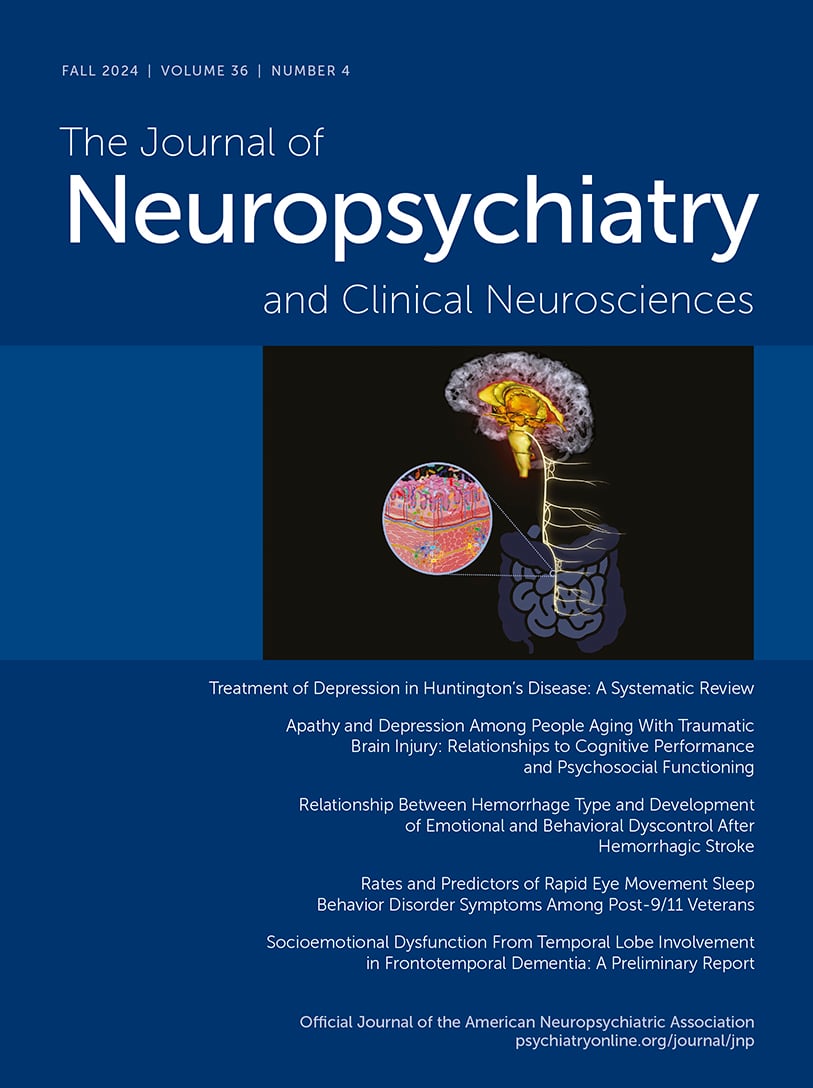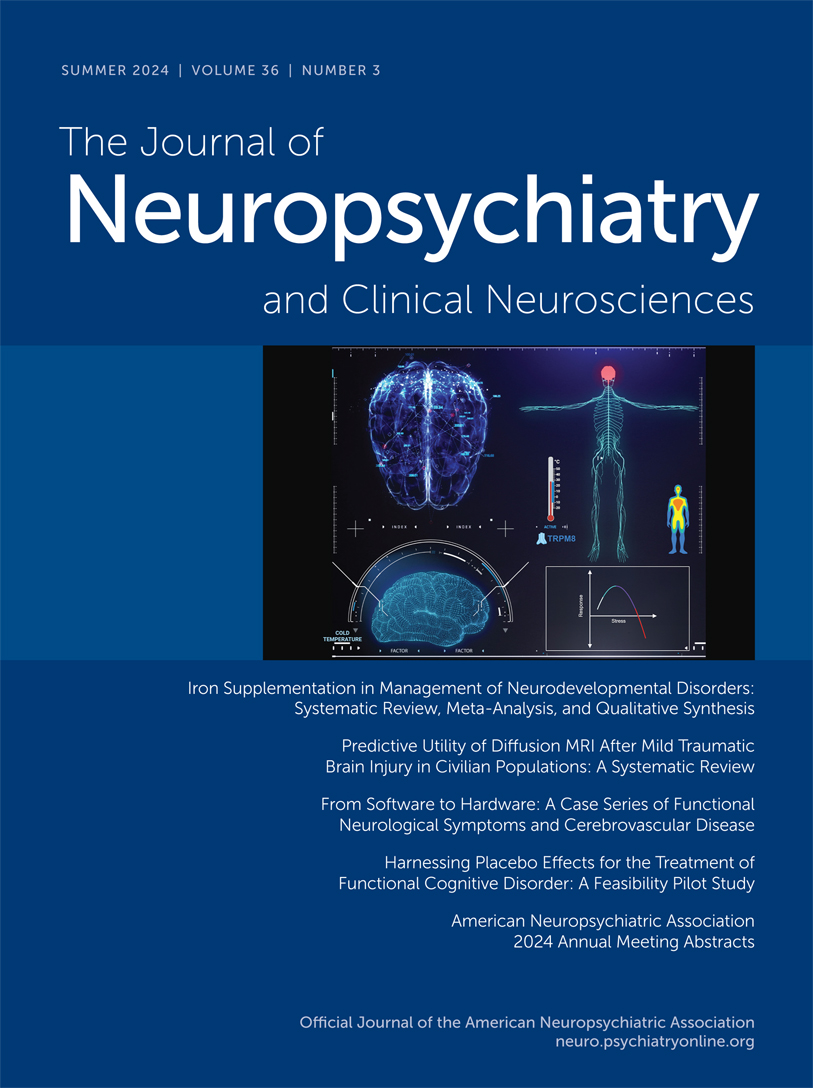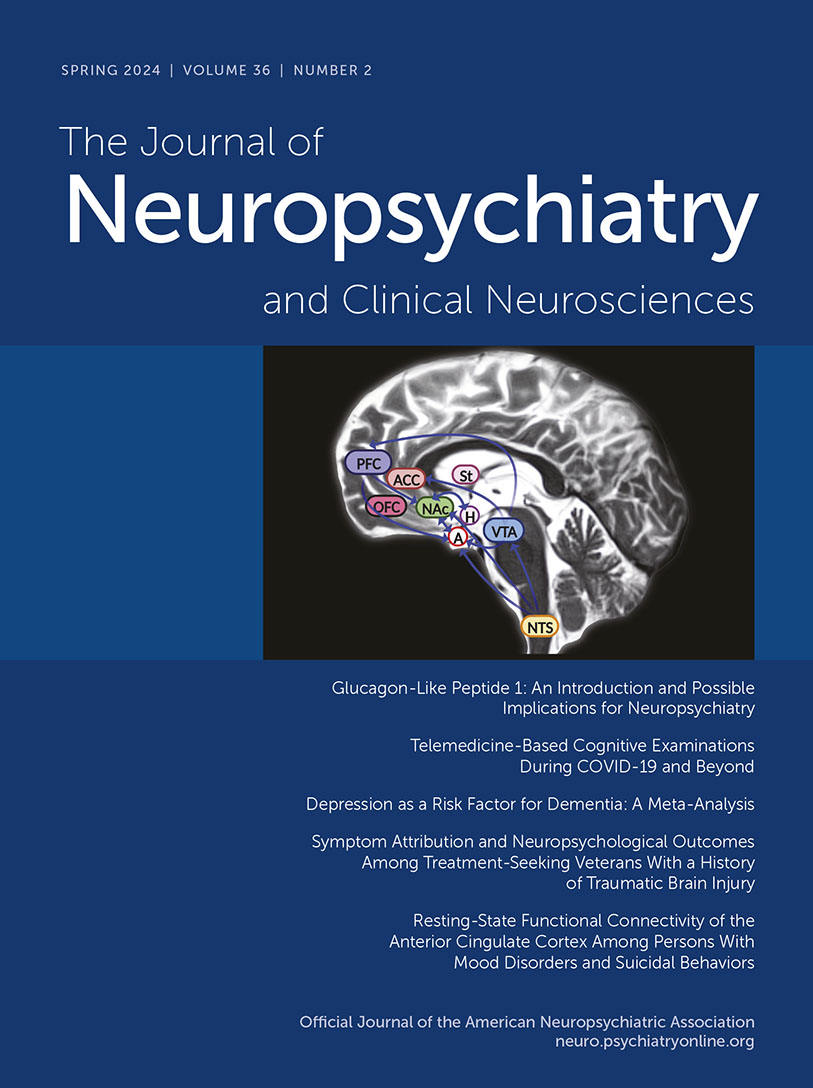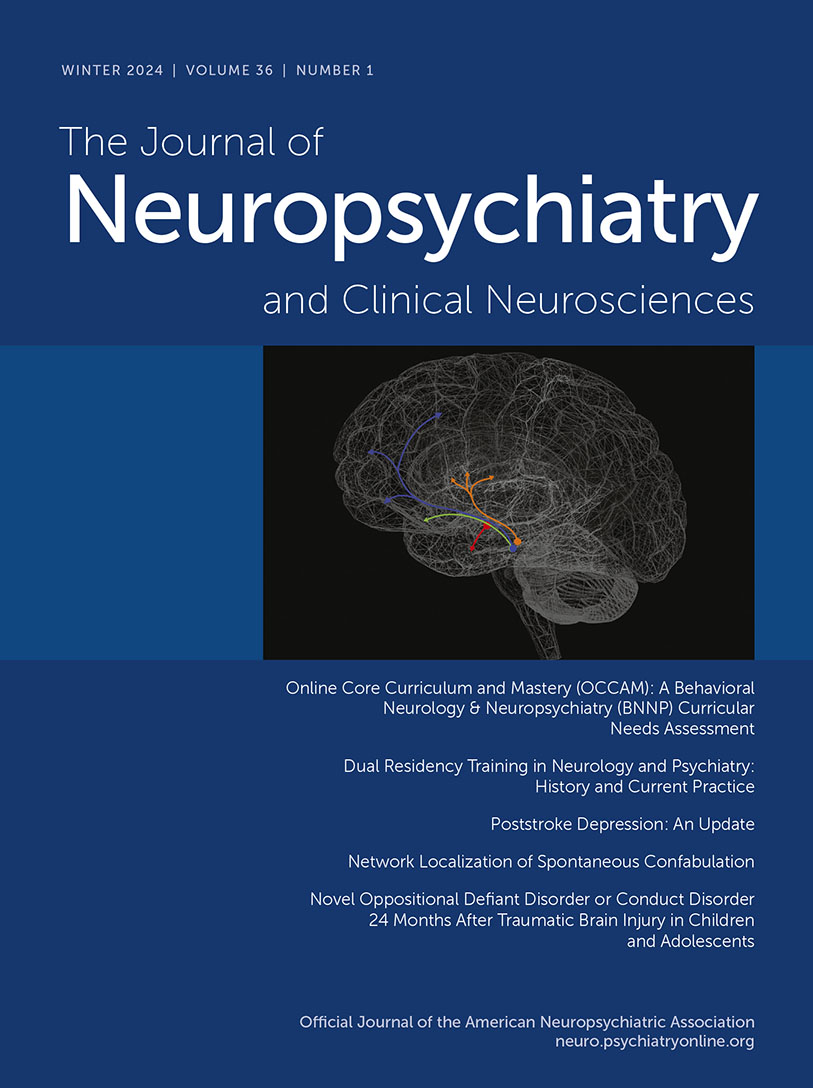The Journal of Neuropsychiatry and Clinical Neurosciences
- Volume 23
- Number 4
- October 2011
Letters
Windows to the Brain
Publication date: 01 October 2011
Pages369–374This issue's Windows to the Brain series describes this heterogeneous condition, in which demyelinization occurs because of nutritional or electrolyte stress, that is, imbalance due to overly-rapid correction of hyponatremia, often in the presence of ...
https://doi.org/10.1176/jnp.23.4.jnp369Special Articles
Publication date: 01 October 2011
Pages375–383Epilepsy and consciousness are intimately related. Epileptic seizures can cause impairment of consciousness, and the study of how this occurs has informed us about the neural mechanisms that underlie normal consciousness. Moreover, loss of consciousness ...
https://doi.org/10.1176/jnp.23.4.jnp375Publication date: 01 October 2011
Pages384–390Hashimoto's encephalopathy, first described in 1966, is still problematic in terms of its pathophysiology, diagnosis, and treatment. The syndrome is more common in women, and is associated with autoimmune antithyroid antibodies. Presentation varies ...
https://doi.org/10.1176/jnp.23.4.jnp384Regular Articles
Publication date: 01 October 2011
Pages391–398This study evaluated neurocognitive functioning in 26 youth with Pediatric Autoimmune Neuropsychiatric Disorders Associated with Streptococcal infections (PANDAS) and primarily obsessive-compulsive disorder (OCD) symptoms. Marked impairment in ...
https://doi.org/10.1176/jnp.23.4.jnp391Publication date: 01 October 2011
Pages399–402Depression is common in Huntington's disease, but standard rating scales have doubtful validity in this population. Using data from the European Huntington's Disease REGISTRY study, the authors examined the discriminant value of items on the Beck ...
https://doi.org/10.1176/jnp.23.4.jnp399Publication date: 01 October 2011
Pages403–408Crying as a response to emotionally-charged situations varies among individuals, genders, and cultures. The authors assessed crying-proneness, as expressed by the score on the “crying easily” item of the SCL-90 questionnaire, in 65 men and 105 women ...
https://doi.org/10.1176/jnp.23.4.jnp403Publication date: 01 October 2011
Pages409–416Compelling evidence suggests that both schizophrenia and obsessive compulsive disorder (OCD) are related to deviant neurodevelopment. Neurological soft signs (NSS) have been proposed to be a marker of abnormal brain development in schizophrenia. The ...
https://doi.org/10.1176/jnp.23.4.jnp409Publication date: 01 October 2011
Pages417–424Panic disorder has an elevated prevalence in Parkinson's disease (PD). To explore the basis for this co-occurrence, the familial aggregation of panic disorder was examined in patients with PD. Probands and relatives of patients with PD and panic disorder (...
https://doi.org/10.1176/jnp.23.4.jnp417Publication date: 01 October 2011
Pages425–433The authors describe the neuropsychiatric spectrum of voltage-gated potassium-channel complex (VGKC) autoimmunity among 67 seropositive patients; 2 had initially been assigned a primary psychiatric diagnosis. Diverse manifestations were recorded, often ...
https://doi.org/10.1176/jnp.23.4.jnp425Publication date: 01 October 2011
Pages434–441This study examined the incidence and course of apathy in subjects with Huntington's disease (HD). Our results showed that at follow-up 14% of the subjects free of apathy at baseline had developed apathy. In these subjects, a lower baseline Mini-Mental ...
https://doi.org/10.1176/jnp.23.4.jnp434Publication date: 01 October 2011
Pages442–448The authors measured levels of interleukin-6 (IL-6) and its soluble receptor in the serum of a small series of MS patients in relapse, patients in remission, and control subjects, co-measuring levels of depression. Results indicated that depression is not ...
https://doi.org/10.1176/jnp.23.4.jnp442Clinical Research Reports
Publication date: 01 October 2011
Pages449–453The authors used clock-drawing performance to assess cognition and predict inpatient rehabilitation outcomes among persons with traumatic brain injury. Clock-drawing performance, as assessed with the Clock Drawing Interpretation Scale, predicts ...
https://doi.org/10.1176/jnp.23.4.jnp449Publication date: 01 October 2011
Pages454–456Does “partial” posttraumatic stress disorder (PTSD) occur after head injury? The authors found that attention bias to trauma-related threat stimuli and higher heart rate during trauma interview were not associated with PTSD symptom severity in 42 ...
https://doi.org/10.1176/jnp.23.4.jnp454Publication date: 01 October 2011
Pages457–460Predictors of social functioning deficits were assessed in 22 individuals “at risk” for psychosis. Disorganized symptoms and executive functioning predicted social functioning at follow-up. Early intervention efforts that focus on social and cognitive ...
https://doi.org/10.1176/jnp.23.4.jnp457Letters
Appreciation to Reviewers
Index to Volume 23
Past Issues
View Issues Archive
Vol. 36 | No. 4

Vol. 36 | No. 3

Vol. 36 | No. 2
